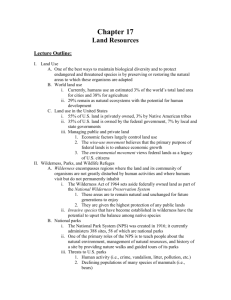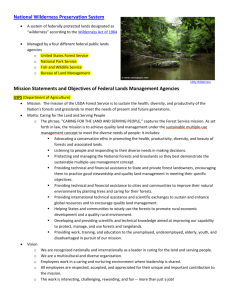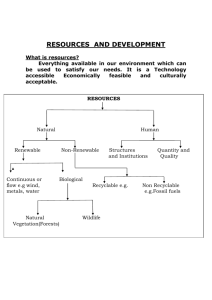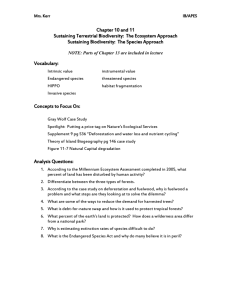Environmental Science Chpt 18 Outline
advertisement
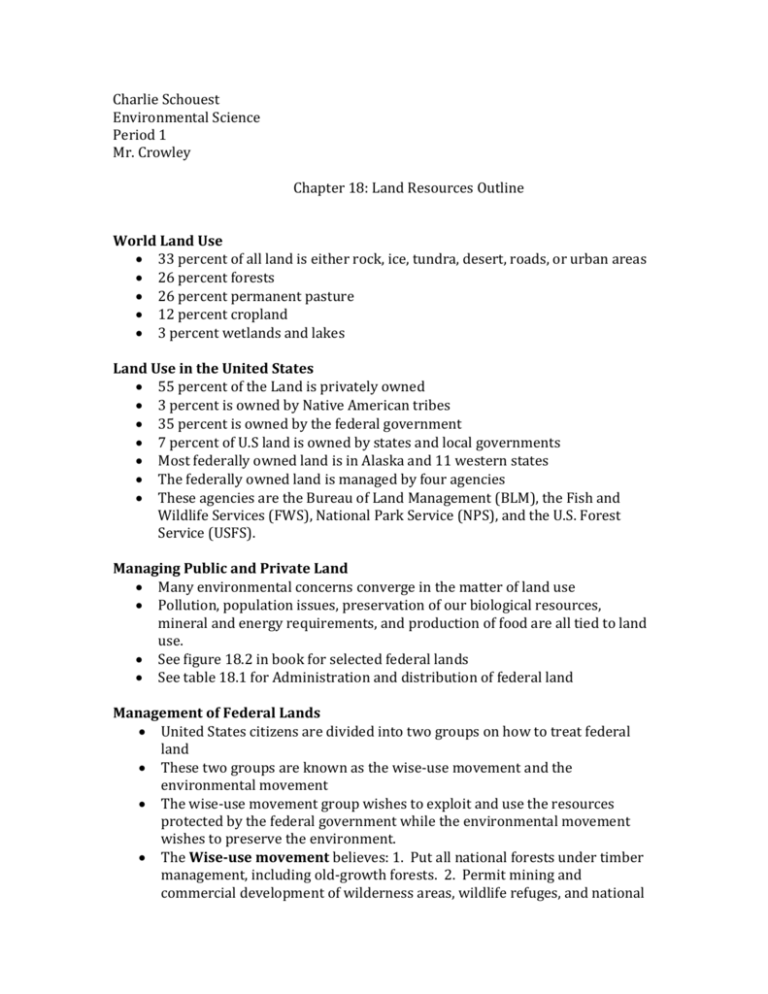
Charlie Schouest Environmental Science Period 1 Mr. Crowley Chapter 18: Land Resources Outline World Land Use 33 percent of all land is either rock, ice, tundra, desert, roads, or urban areas 26 percent forests 26 percent permanent pasture 12 percent cropland 3 percent wetlands and lakes Land Use in the United States 55 percent of the Land is privately owned 3 percent is owned by Native American tribes 35 percent is owned by the federal government 7 percent of U.S land is owned by states and local governments Most federally owned land is in Alaska and 11 western states The federally owned land is managed by four agencies These agencies are the Bureau of Land Management (BLM), the Fish and Wildlife Services (FWS), National Park Service (NPS), and the U.S. Forest Service (USFS). Managing Public and Private Land Many environmental concerns converge in the matter of land use Pollution, population issues, preservation of our biological resources, mineral and energy requirements, and production of food are all tied to land use. See figure 18.2 in book for selected federal lands See table 18.1 for Administration and distribution of federal land Management of Federal Lands United States citizens are divided into two groups on how to treat federal land These two groups are known as the wise-use movement and the environmental movement The wise-use movement group wishes to exploit and use the resources protected by the federal government while the environmental movement wishes to preserve the environment. The Wise-use movement believes: 1. Put all national forests under timber management, including old-growth forests. 2. Permit mining and commercial development of wilderness areas, wildlife refuges, and national parks, where appropriate. 3. Allow unrestricted development of wetlands. 4. Change the Endangered Species Act so that economic factors are considered along with scientific factor. 5. Sell parts of resource-rich federal lands to private interests, such as mining, oil, coal, ranching, and timber groups, for sustainable resource extraction. Environmental movement believes that: the primary purpose of public lands is to protect biological diversity and ecosystem integrity, those who extract resources from public lands should pay U.S. citizens compensation equal to the fair market value of the resource and not be subsidized by taxpayers, and lastly those who use public lands should be accountable for any environmental damage they cause. Wilderness Wilderness encompasses regions where the land and its community of organisms are not greatly distributed by human activities and where humans visit but do not permanently inhabit. Wilderness Act of 1964 authorized the U.S. government to set aside federally owned land that retains its primeval character and lacks permanent improvements or human habitation National Wilderness Preservation System 42 percent of wilderness areas are in national parks 33 percent of national forests are wilderness areas 22 percent of national wildlife refuges are wilderness area More than one half of the lands in the National Wilderness Preservation System lie in Alaska National Parks In 1872 Congress established the world’s first national park, Yellowstone National Park, in the federal lands in territories of Montana and Wyoming. The National Park System was created in 1916 as a new federal bureau in the Department of Interior and given the responsibility to administer the national parks and monuments. The Land and Water Conservation act of 1965 provided money for several national parks we have today. Wildlife Refuges The National Wildlife Refuge System was established in 1903 by Teddy Roosevelt The National Wildlife Refuge System contains more than 535 refuges, with at least one in each of the 50 states. The system encompasses 95 million acres of land The mission of The National Wildlife Refuge System is to preserve lands and waters for the conservation of fishes, wildlife and plants in the United States. Forest Forests are important ecosystems that provide many goods and services to support human society, occupy less than one-third of Earth’s total land area. Timber harvested from forests is used for fuel, construction materials, and paper products Forests influence local and regional climate conditions Transpiration is the result of a biological cooling in which water from soil is absorbed by roots, transported through plants, and then evaporated from their leaves and stems. Forests also play an essential role in regulating global biogeochemical cycles, such as those for carbon and nitrogen Trees in forests have roots that hold vast tracts of soil in place, reducing erosion, and mudslides Forests protect watersheds because they absorb, hold, and slowly release water Deforestation The most serious problem facing the world’s forest is deforestation According to the FAO’s latest estimates, forests are shrinking about 22.2 million acres each year Causes of deforestation include fires caused by drought and land clearing practices, expansion of agriculture, construction of roads in forests, tree harvests, and insects and disease Deforestation results in decreased soil fertility through rapid leaching of the essential mineral nutrients found in most forest soils Deforestation contributes to the extinction of many species Deforestation is thought to induce regional and global climate changes Forest Trends in the United States In recent years, most temperate forests in the Rocky Mountains, Great lakes region, and New England and other eastern states have been holding steady or even expanding. In the U.S. 57 percent of forests are privately owned 20 percent are owned by the federal government 15 percent are owned by Corporations 8 percent are owned by state and local governments The Forest legacy program is a bill that helps private landowners protect environmentally important forestlands from development According to the USFS the U.S. has 155 national forests encompassing 191 million acres of land Agricultural Lands The United States has more than 300 million acres of prime farmland Prime farmland is land that has the soil type, growing conditions, and available water to produce food, forage, fiber, and oilseed crops. According to the American Farmland Trust, more than 400,000 acres of prime U.S. farmland are lost each year The 1996 Farm bill included funding for the establishment of a national Farmland Protection Program This voluntary program helps farmers keep their land in agriculture Wetlands The Wetlands are lands transitional between aquatic and terrestrial ecosystems Wetlands recharge groundwater and reduce damage from flooding because they hold excess water when rivers flood their banks Wetlands also improve water quality by trapping and holding nitrates and phosphates from fertilizers Wetlands also provide habitat for many species listed as endangered or threatened More than half the wetlands that existed originally in the U.S. are now gone Only 104 million acres remain The loss of wetlands is legislatively controlled by a section of the 1972 Clean Water act Coastlines Coastal wetlands, also called saltwater wetlands, provide food and protective habitats for many aquatic animals. Many Coastal areas are overdeveloped, highly polluted, and overfished About 2/3 of the world lives within 93 miles of a coastline The National Marine Sanctuary Program is in charge of the conservation, recreation, education, mining of some resources, scientific research, and ship salvaging near the coastline
